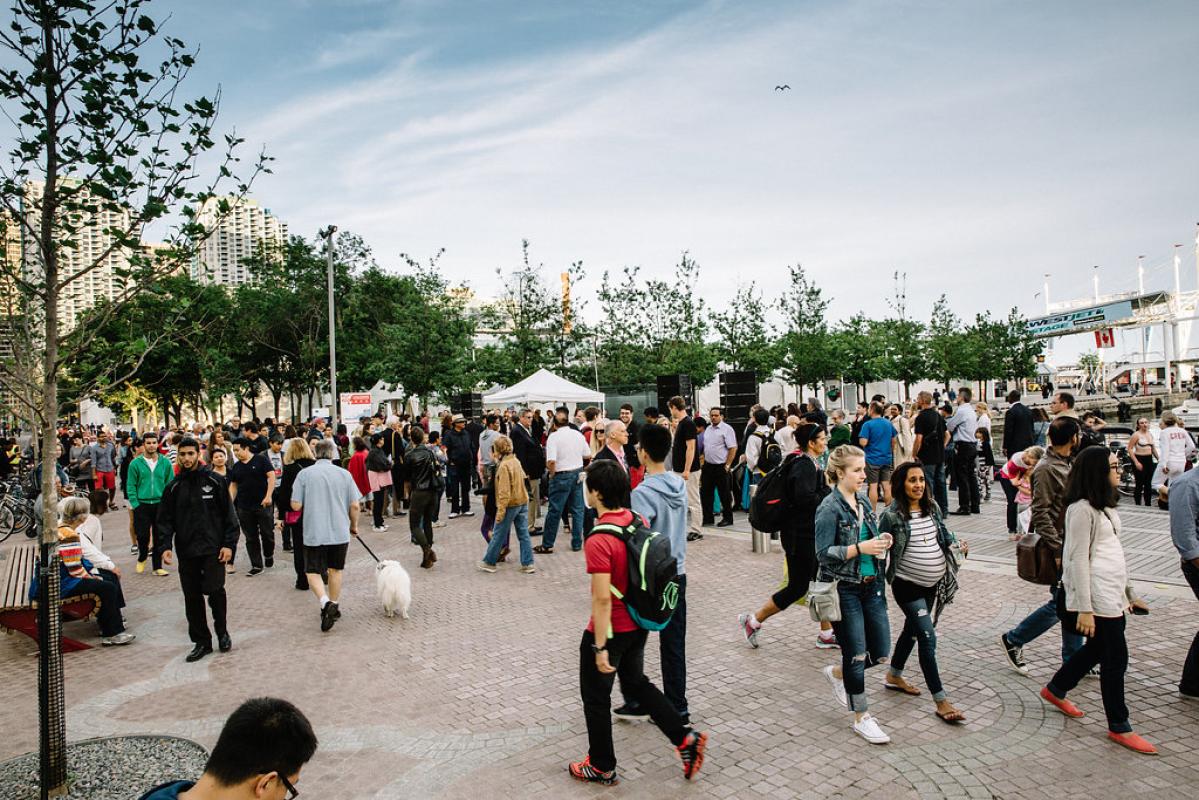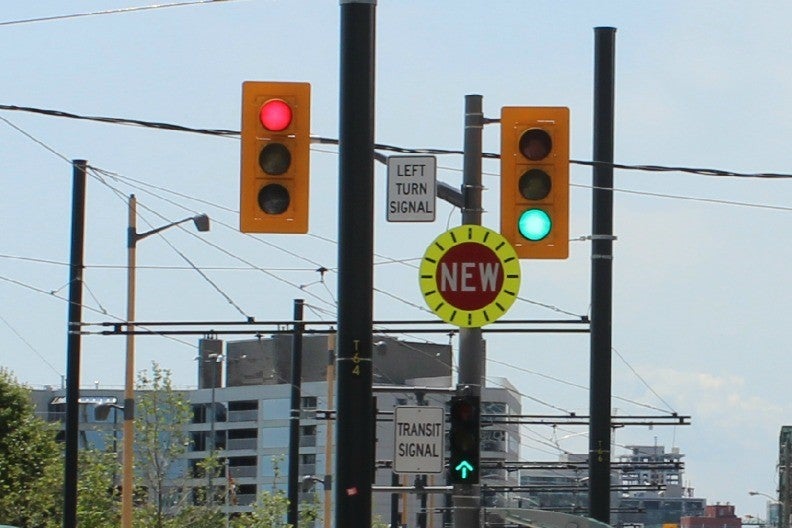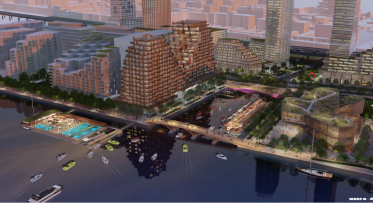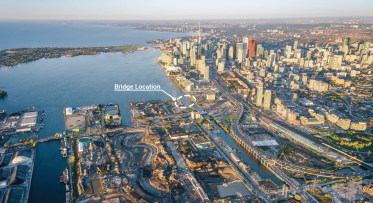What We’re Doing to Improve Queens Quay: An Update
Waterfront Toronto, the City of Toronto and TTC are reviewing some minor adjustments that will help reinforce some of the existing regulatory signs and signals on the new Queens Quay. As these adjustments are approved by the City and TTC, we’ll start to implement them. (Photo: Connie Tsang)
POSTED: JUNE 30, 2015 I DESIGN, INFRASTRUCTURE, CYCLING, PARKS AND PUBLIC SPACES
By Mira Shenker
After observing the street closely every day, we’ve confirmed where adjustments will help reinforce existing regulatory signage/signals and where enforcement is needed. The list of changes being made on the street has also been updated below.
We’ve received lots of feedback about the new Queens Quay over the last two weeks from stakeholders and residents. We’re taking that feedback seriously, and are also observing the street ourselves every day.
Based on what we’re hearing and seeing, it seems that drivers, pedestrians and cyclists aren’t heeding the standard signs, signals and line painting that are there to guide them through the street’s new intersections and driveways. So, we’re working on a few small changes to make these cues even more clear and to make the street as safe as possible.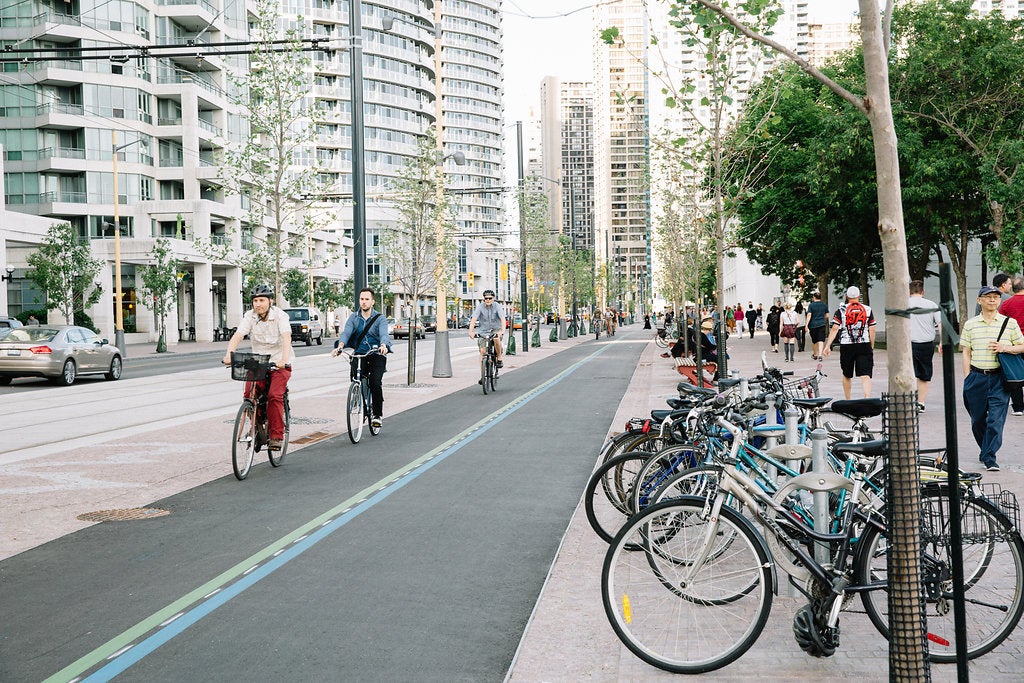
Extensive traffic studies, modelling, consultation and review went into designing a street that is both safe and efficient for everyone using it. The traffic rules and corresponding signage, signals and line painting that Waterfront Toronto, the City of Toronto and TTC approved for this street are based on the typical behaviors of drivers, pedestrians and cyclists – that’s why they are all codified in the Ministry of Transportation’s guidelines. Even the minor adjustments we’re proposing to optimize the street’s flow and alleviate any confusion must be considered with the same rigour. We’re working with the City and TTC to determine which changes can make the street even better, and to ensure proposed changes make sense in the context of the drawings and studies that Waterfront Toronto, the City and TTC reviewed and approved during the design stages.
Last week, We updated you on some of the trends we’ve identified that will need to be addressed with new or different signage and line painting. (Read that post here.) We’ve since met with the City of Toronto and TTC and put a handful of changes in motion.
Click here to see a slideshow of some basic do’s and don’ts on the new Queens Quay
Pictured here: Transit signal head with green arrows (below), signal head for through traffic (right), and signal head for left turns (left).
Changes that have already been made
- Transit signal lights (for streetcars) were changed from globes to arrows and enclosed in long hoods to reduce the chance of drivers mistaking it for a left-hand turn signal
- Brightly coloured Starburst signs that indicate new signals have been added at key intersections to draw attention to dedicated turning signals
- Dedicated turn signal signs and “transit signal” signs have been moved closer the appropriate signal heads where possible
- Streetcars along this stretch have slowed down and transit signal timing has been slightly adjusted to accommodate this
Changes that are approved by the City, TTC and Waterfront Toronto project team
These updates are based on information about when materials will be available. As the necessary material becomes available, crews are set to begin work.
- Waterfront Toronto and the City have requested an increase in local police presence to help enforce traffic and parking rules. Update: police have increased their presence on Queens Quay between Bay and Yo Yo Ma. They are there to help educate people, but will also ticket, as appropriate, those who are willfully ignoring traffic rules.
- “Do Not Enter” signs will be added over the streetcar right-of-way at every intersection. Update: These signs have all been installed.
- Oversized “Left Hand Turn” and “Transit Signal” signs will be installed at all intersections. Update: We are considering some adjustments to the signal heads themselves that would make oversized signs redundant.
- Additional illegal turn signs will be added at every intersection. Update: These signs have been installed.
- A working group made up staff from the City of Toronto’s Transportation and Cycling departments and Waterfront Toronto will examine possible enhancements to the mixing zones at intersection and driveways, including changes to line painting. Update: This review is ongoing.
- Speed limit (20km/h) signs will be added to the Martin Goodman Trail. Update: Speed limits are marked on the Martin Goodman Trail signage which identifies the trail as open to joggers, rollerbladers and cyclists. These signs have all been installed.
- “Stop here on Red” markings will be added to the blue bicycle boxes on the Martin Goodman Trail to help cyclists stop at the right place and not block pedestrian crossing areas. Update: This painting is done.
- Bike stencils will be added to the Martin Goodman Trail to help cue pedestrians that the space is not for walking. Update: This change is being reviewed, after which we will have more information.
- “Watch for cyclists and pedestrians” signs will be installed next week at non-signalized driveways to cue drivers to use caution. Update: These signs have been installed.
- “Slow, watch for turning vehicles” signs will be installed on the Martin Goodman Trail at non-signalized driveways to cue cyclists to slow down. Update: These signs have been installed.
- A “No U-turn” sign will be added to the spot where Queens Quay crosses over the streetcar right of way west of Yo Yo Ma Lane. Update: This sign has been installed.
- The dotted white lines guiding cars to the Harbour Square Laneway at York Street will be removed to avoid confusion as cars head for the eastbound lane on Queens Quay.
- Signage identifying the Harbour Square Laneway entrance at York Street will be installed. Update: This signage has been installed.
- We’re fine tuning the detection cameras that control the traffic signal timing at some intersections to reduce north-south waiting times and improve traffic flow. This will be complete by the end of the summer.
- We've added temporary signs cautioning cyclists to be aware of pedestrians as the approach intersections, crossings and driveways.
Changes that are being considered
- Descriptive signs at dedicated turning signals to remind drivers to wait for their left turn signal
- Relocating signal heads for all dedicated turn signals
- Additional signage to alert cyclists as they approach the trail gap at the Portland Slip. Update: Larger “dismount” signs have been installed. Additional text will be added to clarify for cyclists why they are being directed to dismount.
All of the new intersections, signals and signage have been designed collaboratively with the City of Toronto and TTC, and in line with the Ministry of Transportation’s rules and guidelines. We continue to work closely with the City and the TTC to determine which changes could best reinforce the existing visual cues put in place to create a safe, efficient flow of traffic.
Some changes are more complex than they seem. The Ministry of Transportation develops standards so that signs and signals are consistent and recognizable province-wide. Anything unconventional, such as a custom sign or atypical signal placement, needs to be reviewed by a City Committee to make sure it’s clear and in line with what drivers and pedestrians would expect to see.
Proposed changes to improve visual cues for drivers, cyclists and pedestrians, as well as our recommendations for changes to signal placement and signage, will also be reviewed by an interdisciplinary working group with members from the TTC, City Transportation Services, Toronto Police and Waterfront Toronto staff.
Do’s and Don’ts on the new Queens Quay
Anyone – a pedestrian, cyclist or driver – should be cautious when using an unfamiliar street. This street only works if drivers, cyclists and pedestrians obey the rules. Everyone on the street should be observing signs and pavement markings and driving, walking or cycling with caution. Several of the maneuvers featured in this slideshow are illegal and enforceable by local Police.
We want to hear from you
To supplement our observations, we’re also seeking feedback from the public. We’ll collect feedback over the summer and consolidate it with our own observations, helping us to identify trends and issues that need to be addressed. We’ll then review these findings with the project team, City of Toronto and TTC, agree on solutions and implement them.
Fill out this online form or contact us at info@waterfrontoronto.ca.
We’ll release an official report outlining our findings and solutions – both planned and executed – in September 2015. At that time, we will also hold a more formal public consultation meeting.
To learn more about some of the new design elements on Queens Quay – and for a list of FAQs about the new street – read here.

